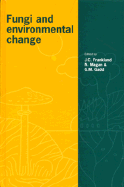Book contents
- Frontmatter
- Contents
- List of contributors
- Preface
- 1 Effects of climate change on fungal diseases of trees
- 2 Effects of climate change on Fusarium foot rot of winter wheat in the United Kingdom
- 3 Effects of UV-B radiation (280–320 nm) on foliar saprotrophs and pathogens
- 4 Implications of global warming and rising sea-levels for macrofungi in UK dune systems
- 5 Red Data Lists and decline in fruiting of macromycetes in relation to pollution and loss of habitat
- 6 Effects of dry-deposited SO2 and sulphite on saprotrophic fungi and decomposition of tree leaf litter
- 7 Effects of atmospheric pollutants on phyllosphere and endophytic fungi
- 8 Influences of acid mist and ozone on the fluorescein diacetate activity of leaf litter
- 9 Mycorrhizas and environmental stress
- 10 Myccorhizas, succession, and the rehabilitation of deforested lands in the humid tropics
- 11 Potential effects on the soil mycoflora of changes in the UK agricultural policy for upland grasslands
- 12 Uptake and immobilization of caesium in UK grassland and forest soils by fungi, following the Chernobyl accident
- 13 Effects of pollutants on aquatic hyphomycetes colonizing leaf material in freshwaters
- 14 Fungi and salt stress
- 15 Fungal sequestration, mobilization and transformation of metals and metalloids
- 16 Urban, industrial and agricultural effects on lichens
- 17 Fungal interactions with metals and radionuclides for environmental bioremediation
- 18 Impact of genetically-modified microorganisms on the terrestrial microbiota including fungi
- 19 Has chaos theory a place in environmental mycology?
- Index of generic and specific names
- Subject index
12 - Uptake and immobilization of caesium in UK grassland and forest soils by fungi, following the Chernobyl accident
Published online by Cambridge University Press: 05 November 2011
- Frontmatter
- Contents
- List of contributors
- Preface
- 1 Effects of climate change on fungal diseases of trees
- 2 Effects of climate change on Fusarium foot rot of winter wheat in the United Kingdom
- 3 Effects of UV-B radiation (280–320 nm) on foliar saprotrophs and pathogens
- 4 Implications of global warming and rising sea-levels for macrofungi in UK dune systems
- 5 Red Data Lists and decline in fruiting of macromycetes in relation to pollution and loss of habitat
- 6 Effects of dry-deposited SO2 and sulphite on saprotrophic fungi and decomposition of tree leaf litter
- 7 Effects of atmospheric pollutants on phyllosphere and endophytic fungi
- 8 Influences of acid mist and ozone on the fluorescein diacetate activity of leaf litter
- 9 Mycorrhizas and environmental stress
- 10 Myccorhizas, succession, and the rehabilitation of deforested lands in the humid tropics
- 11 Potential effects on the soil mycoflora of changes in the UK agricultural policy for upland grasslands
- 12 Uptake and immobilization of caesium in UK grassland and forest soils by fungi, following the Chernobyl accident
- 13 Effects of pollutants on aquatic hyphomycetes colonizing leaf material in freshwaters
- 14 Fungi and salt stress
- 15 Fungal sequestration, mobilization and transformation of metals and metalloids
- 16 Urban, industrial and agricultural effects on lichens
- 17 Fungal interactions with metals and radionuclides for environmental bioremediation
- 18 Impact of genetically-modified microorganisms on the terrestrial microbiota including fungi
- 19 Has chaos theory a place in environmental mycology?
- Index of generic and specific names
- Subject index
Summary
Introduction
Following the Chernobyl nuclear reactor accident in 1986, there has been much scientific effort to establish the extent of radiocaesium contamination of the terrestrial environment, and to determine the propensity for radiocaesium to transfer to plants and through the food chain to man. In upland ecosystems (grassland and forest) fungi play a major role in controlling cycling of nutrients in soil and, through mycorrhizal associations, the uptake of nutrients into plants. Little attention, however, has been directed at understanding the role of fungi in the movement and availability of Cs in soil.
It has been shown that radiocaesium may be accumulated in the basidiomes of basidiomycete fungi (Haselwandter, 1978; Eckl, Hofmann & Turk, 1986; Elstner et al., 1987; Byrne, 1988; Dighton & Horrill, 1988; Haselwandter, Berreck & Brunner, 1988; Oolberkkink & Kuyper, 1989; Watling et al., 1993). Post-Chernobyl levels of radiocaesium in fruiting structures range from background to 15 000 Bq kg-1 dry wt depending on author, fungal species and locality. Ectomycorrhizal basidiomycete species investigated by Byrne (1988) contained a range from background to 117 Bq kg-1 dry wt of total radiocaesium; Dighton and Horrill (1988) recorded a range of 3890–15 820 Bq kg-1 dry wt for the basidiomes of the ectomycorrhizal species Lactarius rufus and Inocybe longicystis. The more recent study of Watling et al. (1993) showed 137Cs contents of fruiting structures from a range of fungal species from different habitats in the UK.
- Type
- Chapter
- Information
- Fungi and Environmental Change , pp. 184 - 200Publisher: Cambridge University PressPrint publication year: 1996
- 14
- Cited by

